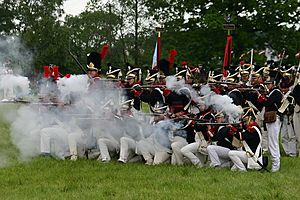Battle of Radzymin (1809) facts for kids
Quick facts for kids Battle of Radzymin (1809) |
|||||||
|---|---|---|---|---|---|---|---|
| Part of the Polish–Austrian War and War of the Fifth Coalition | |||||||
 Re-enactors in uniforms of Polish 1809 infantry |
|||||||
|
|||||||
| Belligerents | |||||||
| Commanders and leaders | |||||||
| Jozef Poniatowski Michał Sokolnicki Michal Ignacy Kamienski Jan Henryk Dąbrowski |
Johann Friedrich von Mohr [de] | ||||||
| Units involved | |||||||
| 7,000, 4 guns | 5,000, 14 guns | ||||||
| Casualties and losses | |||||||
| 150–200 | 400 | ||||||
The Battle of Radzymin was a fight that happened on April 25, 1809. It was part of a short war between Poland (the Duchy of Warsaw) and Austria. This battle took place in Radzymin, a town about 20 kilometers (12 miles) northeast of Warsaw.
Contents
Leading Up to the Battle
After the Battle of Raszyn
A few days before Radzymin, on April 19, the Battle of Raszyn took place. After this battle, Polish forces, led by Prince Józef Poniatowski, left Warsaw unprotected. They moved to nearby strongholds like Modlin Fortress and Serock.
Austrian Occupation of Warsaw
The Austrian army then took over Warsaw on April 23. But this was a "pyrrhic victory." This means they won, but it cost them a lot. Their army was spread out too much. Also, the Polish army was still strong nearby. New Polish forces were also gathering in Greater Poland.
Austrian Army Movements
Prince Este, the Austrian commander, left 10,000 soldiers in Warsaw. He sent about 6,000 troops, led by General Johann Friedrich von Mohr [de], to the east side of the Vistula River. The rest of his army went towards Toruń and other places.
Polish Resistance and Attacks
The area of Praga, just across the Vistula from Warsaw, was still held by a small Polish group of 600 men. General Mohr's Austrian forces crossed the river near Karczew. On April 24, they began to surround the small Polish group in Praga.
However, the next day, Polish soldiers from Modlin Fortress attacked the Austrians from behind. This fight was called the Battle of Grochów. The main part of the Austrian force was defeated, and the Poles successfully pulled back.
Forces at Radzymin
At the same time, further northeast in Radzymin, another Polish force attacked the Austrians. The town of Radzymin was held by a smaller Austrian group. This group included two battalions of infantry and some hussars (cavalry).
The Polish force was similar in size. It had a group of uhlans (lancers) and one infantry battalion. They also had a small artillery unit with two cannons.
The Battle of Radzymin
Polish Surprise Attack
On the night of April 24, the Polish force left Serock. They crossed the Narew River and reached Radzymin before sunrise. In the early hours of April 25, the Polish soldiers attacked the town. They attacked from two different directions at the same time.
Austrian Retreat and Surrender
The Austrian soldiers first pulled back to the center of the town. But soon, their cavalry (horse soldiers) had to retreat. This left their infantry battalions (foot soldiers) alone. After a short, close-quarters fight, the two Austrian battalions surrendered. They gave up with their remaining 37 officers.
Results and What Happened Next
Battle Losses
The Polish side had 19 soldiers killed and 27 wounded. The Austrians lost about 2,000 soldiers as prisoners of war. Many more were killed or wounded.
Impact of the Victory
Even though this battle wasn't a huge defeat for the Austrians, it was one of many small fights they lost. These battles happened on the eastern side of the Vistula River. Finally, on May 2 and 3, General Mohr's entire army was defeated at Ostrówek. Their floating bridge across the river was also destroyed.
This stopped the Austrians from moving further east. It gave the Poles enough time to leave the Austrians stuck in Warsaw. The Poles then went on to free much of Galicia with little resistance.

